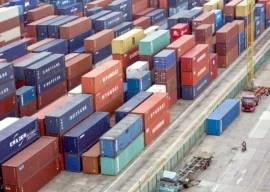
Present demand for natural gas in Pakistan stood at 8 billion cubic feet (bcf) per day during winters whereas production from conventional sources totalled 4.2 bcf. It is no secret that gas supply has been unable to meet demand for many years now. New fields brought online over the last three years have been barely able to maintain the current levels of production.
The reason for this flattening output is the reduced production from main natural gas fields.
This has forced policy-makers to look for alternative sources of domestic natural gas, ie, tight gas, shale gas and coal gasification (converting coal to gas). In the case of shale gas, the question is whether it can help resolve the energy crisis and what it means for the environment.
Geological studies show that gas could be found in deeper, denser “unconventional” shale formations (called plays). Natural gas is stored in shale in three forms – free gas in rock pores, free gas in natural fractures and absorbed gas on organic matter and mineral surfaces.
In the early 2000s, a combination of two existing techniques led to a breakthrough, allowing US companies to produce shale gas. One is horizontal drilling. Drillers penetrate the shale laterally and vertically. This exposes greater surface area of the rocks for extraction and enables multiple wells to be created from each drill pad.
The other is hydraulic fracturing (or fraking), a process involving water, sand and a chemical mixture pushed down a well at thousands of pounds of pressure (as much as 13,500 pounds of pressure per square inch) which causes cracks in the shale and releases the hydrocarbons.
Preliminary studies have shown that at least 33 trillion cubic feet, out of total 204 trillion cubic feet, of unconventional gas reserves trapped in rocks are recoverable from available technology. The Balochistan Basin, the Suleiman Foredeep Basin and the Lower Indus Basin offer significant potential.
In 2011, the Ministry of Petroleum and Natural Resources issued a fresh policy for exploration of unconventional natural gas. Exploration companies are being offered considerable financial incentive to explore and produce natural gas. Leases are being offered for 40 years.
It is for this reason that many international companies have shown interest in the project. Two such companies are Polish gas monopoly PGNiG and ENI of Italy.
However, the production of shale gas is not without its hazards. In addition to being technologically demanding and expensive to produce, the process can be very dangerous for the environment. The liquid used in fraking contains chemicals that are harmful to humans and the habitat.
Ingredients include water and sand (98-99.5%). The remaining chemicals can be hydrochloric acid (initiates cracks), methanol (inhibits corrosion), glutaraldehyde (kills bacteria) and ethylene glycol (winterizes product). In terms of weight, even 0.5% can amount to many tons of toxic material per drill pad.
The biggest risk from these chemicals is in the form of water contamination. These shale gas plays are supposed to be many layers of impenetrable rocks under the water table but when the fraking fluid goes down the well it can leak. The well walls are normally made of two layers of steel casing and two layers of heavy-duty cement. However, the risk exists.
The second possible source of contamination is the large amount of produced (waste) water that comes back out of the well. This chemical-laced water requires treatment before disposal or reuse. In the US, the waste water is emptied into a pit where a lot of it can seep right back down into the ground.
Evaporation techniques are used to reduce the quantity of waste water to be transported from site. This is also extremely dangerous and reports have shown that it can cause health risks to humans and animals alike.
Owing to these and other considerable environmental hazards, the production of shale gas should not be allowed to take place near populated areas or where our sources of water are present. It is clear that the exploration of natural gas is necessary if our economy is to survive, let alone grow.
The upshot is that the days of cheap energy are limited. We must get ready to pay more for our energy. Extraction and processing from unconventional sources will be more expensive and there are considerable environmental hazards that have to be taken into account in granting any concession. In the absence of tight regulations and close monitoring, the pollution of ground water could spell disaster for us and our agriculture.
The writer is a high court lawyer.
Published in The Express Tribune, May 28th, 2012.
COMMENTS (3)
Comments are moderated and generally will be posted if they are on-topic and not abusive.
For more information, please see our Comments FAQ


























Nice article! Very informative
What about conventional gas n balochistan....why dont we got after this now...and also offshore gwadar
What about CBM (coal bed methane)! Thar has potential of 5 TCF and Govt of Sindh or as a matter of fact Federal Govt is not looking for CBM options. The water is extracted first then the trapped methane in coal is released and is capped. Therefore water -- over 50 million gallons per day and gas is available. TWO VERY VALUABLE COMMODITIES IN THAR OTHER THAR COAL!!! Pakistan needs energy and water fast, so kindly don't ignore any option.